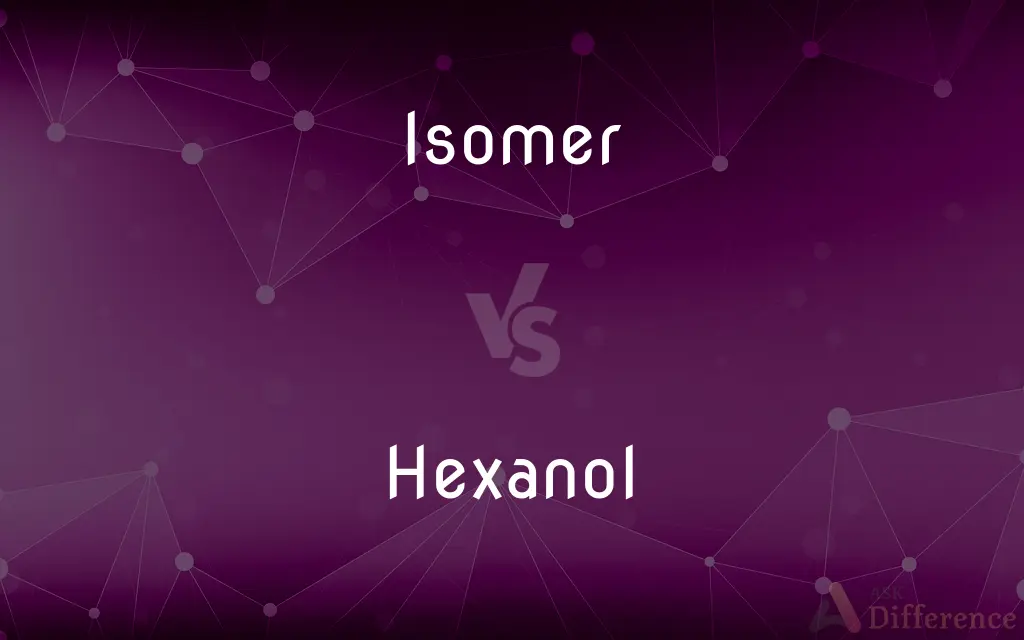Isomer vs. Hexanol — What's the Difference?
Edited by Tayyaba Rehman — By Urooj Arif — Updated on April 6, 2024
An isomer is a molecule with the same molecular formula as another molecule but a different chemical structure, while hexanol refers to any of several isomeric alcohols with six carbon atoms and the formula C6H14O.

Difference Between Isomer and Hexanol
Table of Contents
ADVERTISEMENT
Key Differences
Isomers are compounds that share the same molecular formula but differ in the arrangement of their atoms, leading to different chemical and physical properties. Isomerism can be structural, where the connectivity of atoms differs, or stereoisomeric, where the spatial orientation of atoms varies. Hexanol, on the other hand, serves as a prime example of isomerism in practice. It is a term that can refer to several different compounds, all sharing the formula C6H14O but differing in the structure of the carbon chain and the position of the hydroxyl group (-OH), resulting in distinct physical and chemical properties among the isomers.
While isomerism encompasses a broad and fundamental principle in organic chemistry affecting numerous compounds, hexanol illustrates this principle through its specific isomeric forms. For example, hexanols can be primary, secondary, or tertiary alcohols, depending on the hydroxyl group's attachment, leading to differences in reactivity and boiling points. The study of hexanol and its isomers not only highlights the concept of isomerism but also underscores the importance of structural arrangement in determining the properties of organic substances.
The exploration of isomers, including hexanol, is crucial for various applications, from industrial processes to the synthesis of pharmaceuticals, where specific isomers can have dramatically different effects. The creation and identification of different isomers, such as those of hexanol, rely on analytical techniques like spectroscopy and chromatography, demonstrating the practical importance of understanding isomerism in chemistry.
While isomerism is a fundamental concept in chemistry that describes molecules with identical formulas but different arrangements, hexanol exemplifies this concept through its various isomeric forms, showcasing the significant impact of molecular structure on the properties of chemical compounds.
Comparison Chart
Definition
Molecules with the same molecular formula but different structures.
Alcohols with six carbon atoms and the formula C6H14O.
ADVERTISEMENT
Types
Structural and stereoisomeric.
Primary, secondary, and tertiary alcohols based on the hydroxyl group's position.
Example
Butane and isobutane are isomers with the formula C4H10.
1-hexanol, 2-hexanol, and 3-hexanol are examples of hexanol isomers.
Physical Properties
Vary widely among isomers due to differences in structure.
Vary among hexanol isomers, affecting boiling points and solubility.
Importance
Demonstrates the diversity of organic compounds and affects properties and reactivity.
Highlights the concept of isomerism; specific isomers have unique applications in industry and research.
Compare with Definitions
Isomer
Crucial in pharmaceuticals, where different isomers have different biological effects.
The S and R isomers of a drug may not have the same efficacy.
Hexanol
Exists in several isomeric forms.
2-hexanol and 3-hexanol differ by the position of the hydroxyl group.
Isomer
Compounds with identical formulas but different structures.
Glucose and fructose are isomers (C6H12O6), differing in atom arrangement.
Hexanol
Used in perfumes and flavorings due to its distinct odor and taste.
Hexanol isomers contribute to the aroma of certain fruits.
Isomer
Includes both structural isomers and stereoisomers.
Structural isomers have different connectivity, while stereoisomers differ in spatial orientation.
Hexanol
An alcohol with the molecular formula C6H14O.
1-hexanol has the hydroxyl group at the end of a six-carbon chain.
Isomer
Affects chemical and physical properties.
Isomers can have vastly different boiling points and reactivities.
Hexanol
Properties like boiling point and solubility vary among isomers.
The boiling point of hexanol isomers changes with the hydroxyl group's position.
Isomer
Analyzed using techniques like spectroscopy.
NMR spectroscopy can distinguish between isomers by their atomic environments.
Hexanol
Its isomers have different industrial applications.
Some hexanol isomers are used as solvents or in the synthesis of other chemicals.
Isomer
In chemistry, isomers are molecules or polyatomic ions with identical molecular formulas — that is, same number of atoms of each element — but distinct arrangements of atoms in space. Isomerism is existence or possibility of isomers.
Hexanol
Hexanol may refer to any of the following isomeric organic compounds with the formula C6H13OH:
Isomer
(Chemistry) Any of two or more substances that have the same molecular formula but differ in the way their atoms are connected to each other, in the spatial orientation of their atoms, or, in the case of large molecules such as DNA, in their molecular topology.
Hexanol
(organic compound) Any of many isomers of the saturated aliphatic alcohol having six carbon atoms
Isomer
(Physics) Any of two or more nuclei with the same mass number and atomic number that have different radioactive properties and can exist in any of several energy states for a measurable period of time.
Isomer
(chemistry) Any of two or more compounds with the same molecular formula but with different structure.
Isomer
(physics) Any of two or more atomic nuclei with the same mass number and atomic number but with different radioactive properties. Category:en:Radioactivity
Isomer
A compound which is isomeric with another body or compound; a compound having the same chemical composition as another compound; a member of an isomeric series.
Isomer
A compound that exists in forms having different arrangements of atoms but the same molecular weight
Common Curiosities
Can the properties of hexanol isomers be predicted based on their structure?
Yes, the physical and chemical properties of hexanol isomers can be predicted based on their molecular structure, such as the position of the hydroxyl group affecting their boiling points and solubility.
How does isomerism affect the reactivity of a compound?
Isomerism can significantly affect a compound's reactivity; for instance, the position of functional groups in structural isomers can influence their reaction pathways and the types of reactions they undergo.
Why is it important to control the production of specific isomers in industrial processes?
Controlling the production of specific isomers is important in industrial processes to ensure the desired product's purity and performance, as different isomers can have different physical properties and activities.
What is hexanol?
Hexanol refers to any of several isomeric alcohols with six carbon atoms, characterized by the formula C6H14O.
What role does isomerism play in the pharmaceutical industry?
Isomerism is crucial in the pharmaceutical industry because different isomers of a compound can have vastly different biological activities. The therapeutic effect and toxicity of drugs can depend on their isomeric form.
How does isomerism contribute to biodiversity at the molecular level?
Isomerism contributes to molecular biodiversity by allowing for a variety of compounds with the same molecular formula but different structures, leading to a wide range of chemical behaviors and biological activities.
How do structural and stereoisomers differ?
Structural isomers differ in how their atoms are connected, while stereoisomers have the same connectivity but differ in the spatial arrangement of atoms.
How are isomers identified and differentiated in the laboratory?
Isomers are identified and differentiated using analytical techniques such as chromatography, mass spectrometry, and nuclear magnetic resonance (NMR) spectroscopy, which can distinguish between different structural and spatial arrangements.
Are all hexanol isomers safe for consumption or use in products?
Not all hexanol isomers are equally safe for consumption or use in products; their safety depends on their specific chemical structure, concentration, and the regulatory standards applicable to their use.
What practical applications do hexanol isomers have?
Hexanol isomers have various practical applications, including in the manufacturing of fragrances, flavors, solvents, and in the synthesis of plasticizers, lubricants, and other chemicals.
How does the environment impact the formation of specific hexanol isomers?
The environment, particularly the conditions under which a chemical reaction occurs (such as temperature, catalysts, and solvents), can influence the formation of specific hexanol isomers during synthesis.
Can isomerism lead to differences in smell and taste among compounds?
Yes, isomerism can lead to differences in smell and taste among compounds. For instance, different isomers of hexanol can have distinct odors and flavors, influencing their use in food and fragrance products.
What are isomers?
Isomers are molecules that have the same molecular formula but differ in the arrangement of their atoms, leading to different properties.
What environmental factors can affect the stability of hexanol isomers?
Environmental factors such as light, temperature, and the presence of catalysts or reactive substances can affect the stability of hexanol isomers, potentially leading to their transformation or degradation.
Share Your Discovery

Previous Comparison
Transport vs. Freight
Next Comparison
Receipt vs. VoucherAuthor Spotlight
Written by
Urooj ArifUrooj is a skilled content writer at Ask Difference, known for her exceptional ability to simplify complex topics into engaging and informative content. With a passion for research and a flair for clear, concise writing, she consistently delivers articles that resonate with our diverse audience.
Edited by
Tayyaba RehmanTayyaba Rehman is a distinguished writer, currently serving as a primary contributor to askdifference.com. As a researcher in semantics and etymology, Tayyaba's passion for the complexity of languages and their distinctions has found a perfect home on the platform. Tayyaba delves into the intricacies of language, distinguishing between commonly confused words and phrases, thereby providing clarity for readers worldwide.















































